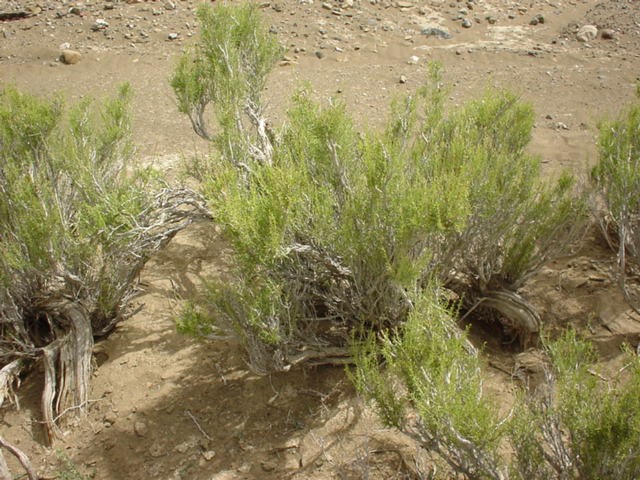
Pteropyrum scopianum / سيداف
Pteropyrum ericoides Boiss
Sidaf
Sidaf
Polygonaceae
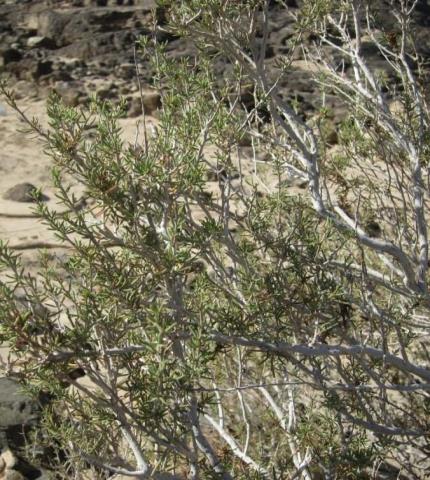
Aerial parts

Herbarium specimen
Ethnobotanical Characteristics
Description
The plant is a Shrub that grows up to 1.5m tall with many twisted branches. Leaves terete, linear, spirally arranged on the stems. Flowers pink, tinged yellow, in axillary fascicles. Stamens orange-red. Fruit 3-lobed, 3-winged, wings membranous, reddish-brown when ripe. Commonly found in the wadis of the foothills of the northern mountains of Oman (Ghazanfar, 1994).
Much branched, robust perennial with smooth grey or whitish stems dotted with tiny scales and warts, to 1.5m. Flowers crowded in axils, with red-tipped stamens. Flowering occurring in February- May. Fruit enclosed by distinctive pink or brown perianth wings that dry out with a papery effect, totally covering plant (Western, 1989).
Habitat and Distribution
Common among boulders and gravels in lower wadis in foothills and alluvial plains close to mountains, found in Ras al Khaima (Western, 1989).
Part(s) Used
Whole plant
Traditional and Medicinal Uses
The leaves are used to treat dyspepsia (Gazanfar, 1994).
Pharmacognosy and Phytochemistry
Parts studied
Dried leaf and stem
General appearance
Leaves are found in clusters. The leaf is small acicular, grayish-green, almost sessile, 8-17 mm long, 1-2 mm broad, slightly curved.
Microscopic characteristics
The leaf: A transverse section of the leaf shows it’s almost circular to slightly oblong outline, and the upper and lower surfaces cannot be easily differentiated. The epidermal layer is covered with a thick striated cuticle. The epidermis is composed of oval to rounded cells that are underlain by two layers of long, thin, compactly packed palisade cells that contain orange-brown masses. Parenchyma cells, each containing a cluster crystal of calcium oxalates, are imbedded between the palisade cells. Also scattered between the palisade cells and the spongy mesophyll cells, which are comparatively large and polygonal or rounded in shape, are individual sclereids with quite different shapes and thick pitted walls. The spongy cells are rich in orange-coloured pigments. Also imbedded in vascular tissues. Epidermal cells embed oval anomocytic stomata.
Stem: It is dark brown in colour, small in size, bearing many slender brittle branches. The transverse section of the stem is almost circular in outline. From the periphery inwards, it shows the following characters: the epidermal layer with small polygonal parenchyma cells, the multi-layered cortex consisting of distorted polygonal cells with thick walls where the outermost layers are brown in colour while the innermost layers are yellowish; distinct medullary rays, phloem and xylem tissues all heavily lignified and the vessels are spirally or annularly thickened; the pith occupies a wide central zone consisting of rounded pitted cell walls, which are thick and lignified and most of them are yellowish in colour.
Powdered plant material
Leaf: The material consists of a light brown, homogeneous, fine powder with a flat taste. It is slightly aromatic but it is practically odorless. Microscopically, the powder shows fragments of the epidermis with thick striated cuticle, scattered orange and orange-brown masses together with individual sclereids of different shapes and thick, pitted cell walls.
Stem: The material consists of a light brown homogeneous powder. It is odorless but has a slight sour, acrid taste. Microscopically, the powder shows fragments of many comparatively long light-yellow fibro-vascular tissues and groups of vessels with accompanying parenchyma cells containing one or two grains of starch.
Slides of the parts studied
Dried leaf and stem
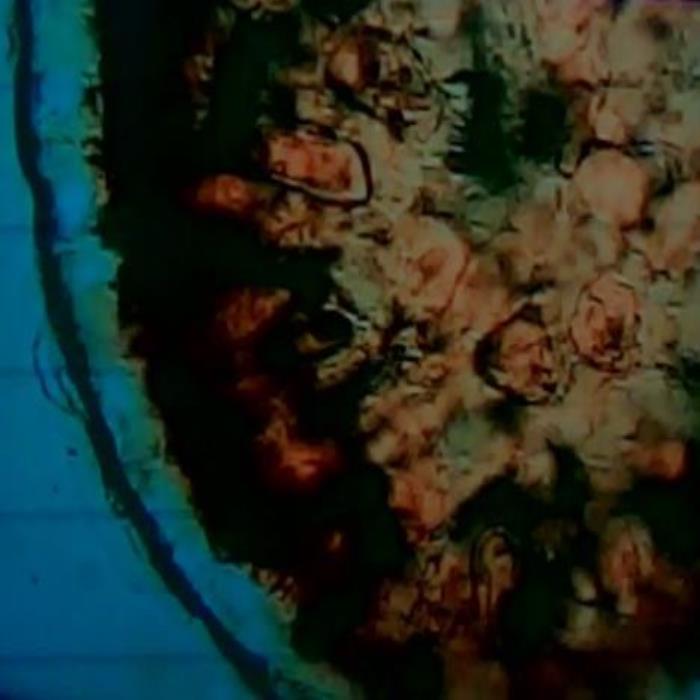
A) TS of leaf
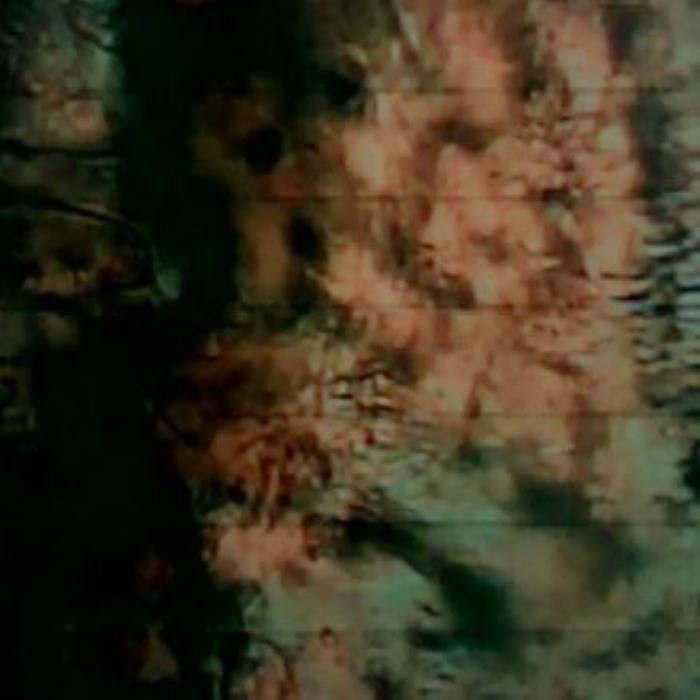
B) Spongy mesophyll
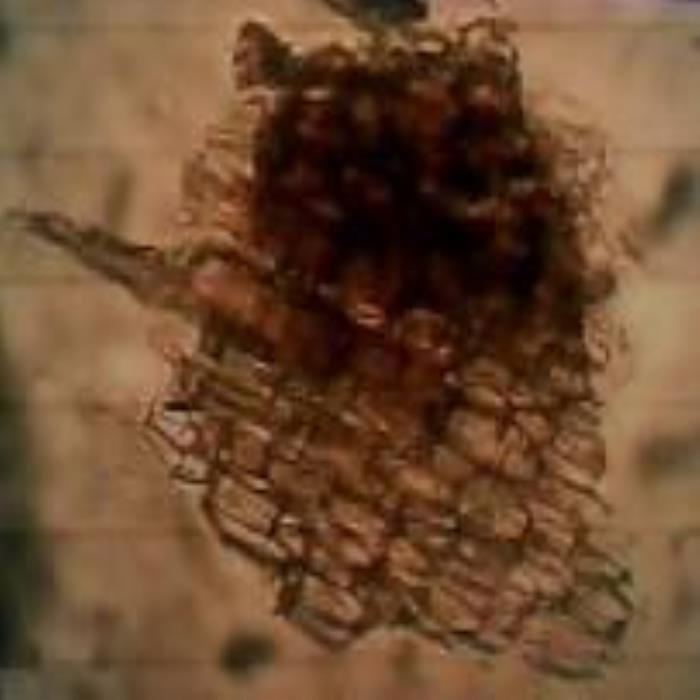
C) Stem surface view
- A. TS of the leaf showing its almost circular outline. From the periphery inwards it exhibits the following: the thick striated cuticle; the epidermis with its oval to rounded cells; two layers of palisade cells between which are embedded parenchyma cells. Each cell has a crystal of calcium oxalate; spongy mesophyll cells, scattered between them are sclereids with thick pitted walls and they also contain orange materials.
- B. TS of a portion of the leaf at the spongy mesophyll showing the scattered sclereids having thick pitted walls.
- C. A fragments of a portion of the stem in surface view showing the epidermal polygonal cells and the outermost layers of the cortex which are distorted and brown in colour (dark colored).
Chemical Constituents
The chemical constituents are alkaloids, steroids, tannins and some flavonoids, whereas saponins or anthraquinone glycosides were found absent.
The following chemical studies have been carried out on the aerial part of the plant Pteropyrum scoparium (Quality Control methods, 1998; Evans, 1996; ZCHRTM unpublished work)
Physicochemical parameters
Loss of weight in drying at 105°C : 8.00
Absolute alcohol solubility : 3.20
Water solubility : 9.00
Successive extractives (%)
Petroleum ether (60-80) °C : 0.55
Chloroform : 0.50
Absolute alcohol : 5.90
Ash values (%)
Total ash : 5.67
Water soluble ash : 1.17
Acid insoluble ash (10% HCl) : Nil
pH values (aqueous solution)
pH of 1% solution : 8.526-8.528
pH of 10% solution : 8.213-8.222
Elemental analyses
Assay and identification of element (AOAC International)
|
Apparatus |
AA-6800 Shimadzu-Flame method |
||||
|
Element |
Std. conc. mg/ml |
Sample conc.mg/ml |
Flame samples absorbance |
Flame Actual conc.mg/ml |
Flame Actual % |
|
Cr |
1, 2, 4 |
10 |
0.0084 |
0.00751 |
0.000751 |
|
Zn |
0.25, 0.5, 1 |
10 |
0.1899 |
0.01641 |
0.001641 |
|
Cu |
1, 2, 4 |
10 |
0.0121 |
0.00540 |
0.000540 |
|
Fe |
1, 2, 4 |
10 |
0.4702 |
0.33304 |
0.033304 |
|
K |
1, 2, 4 |
1 |
0.9275 |
9.2049 |
0.92049 |
|
Pb |
1, 2, 4 |
10 |
0.0009 |
0.00221 |
0.000221 |
|
Cd |
0.25, 0.5, 1 |
10 |
0.0009 |
0.00009 |
0.000009 |
|
Ca |
5, 10, 20 |
10 |
0.2686 |
16.2797 |
1.62797 |
| 1ppm conc. = 1µg/ml; Actual conc. (%) =Actual conc.(ppm)x0.0001 [1ppm=0.0001%] | |||||
UV Spectral studies
|
Ultraviolet Spectrum (USP) |
||||
|
Apparatus |
Milton Roy Spectronic Genesys 5 Spectrophotometer - Milton Roy. |
|||
|
Sample conc. (mg / ml) |
Solvent |
λ max (nm) |
λ min (nm) |
Abs.( λ max - λ min) |
|
1.2775 |
Intestinal Fluid simulated without pancreatic pH=7.50.1 |
280 |
259 |
0.827 - 0.660 |
|
1.005 |
Gastric Fluid simulated without pepsin pH =1.20.1 |
280 |
256 |
0.726 - 0.522 |
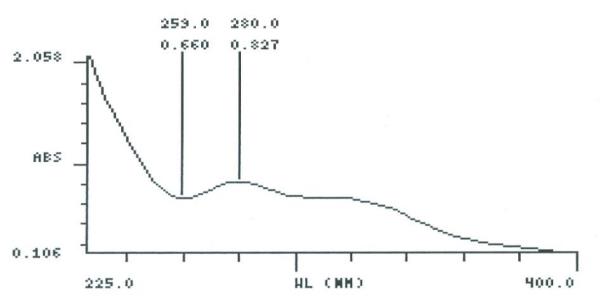
Intestinal Fluid simulated without pancreatic
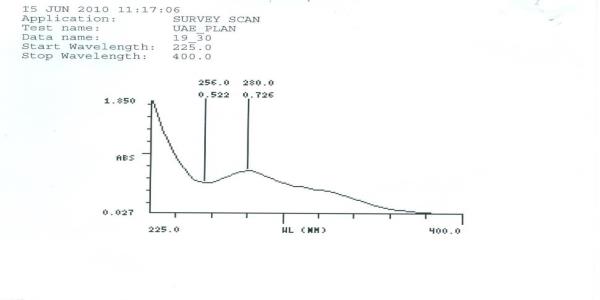
Gastric Fluid simulated without pepsin
Chromatographical Studies
Thin layer chromatography (TLC): Wagner and Bladt, 1996

A

B

C

D
TLC fingerprint of Petroleum ether 60-80°C (track 1) and MeOH extract (track 2)
|
Mobile phase Fig. |
A&B |
: |
Toluene, ethyl formate, formic acid (5:4:1) |
|
|
C |
: |
Toluene, ethyl acetate (93:7) |
|
|
D |
: |
Ethyl acetate, methanol, water (100:13.5:10) |
|
Detection |
A |
: |
UV 254nm |
|
Derivatization |
B&C |
: |
Vanillin-Sulphuric acid –vis. |
Pharmacological and toxicological studies
The important pharmacological and toxicological activities of the plant Pteropyrum scoparium reported in various scientific journals have been summarized below:
Leaves are eaten to treat dyspepsia and as a blood purifying tonic (Sabitha, 2012)
Pteropyrum is a genus of plants in the family polygonaceae with about five species in western Asia. The plant Petrypyrum sp. (Above ground plant part) was studied for acute toxicity in rats (Adaay, 1994; Redo, 1988) describes the antimicrobial compounds isolated from Pteropyrum sp. The review is based on several extracts, essential oils, and other active principles isolated from the plant as antimicrobial agents.
The following pharmacological and safety evaluation studies were carried out at ZCHRTM on the 70% plant extract of Pteropyrum scoparium (Derelanko 2002; Han, 2003).
|
ACTIVITY |
RESULTS |
|||
|
Strong |
Moderate |
Mild |
Negative |
|
|
Anti-inflammatory (Paw edema) |
|
|
√ |
|
|
Anticoagulant effect |
|
|
|
√ |
|
Anti-gastric ulcer activity |
√ |
|
|
|
|
Effect on rabbit jejunum |
|
|
√ |
|
|
Effect on rat fundus |
√ |
|
|
|
|
Effect on Guinea pig ileum |
√ |
|
|
|
|
Anti-diarrhea activity in mice |
√ |
|
|
|
|
Effect on right rat atria |
|
√ |
|
|
|
Effect on Guinea pig tracheal chain |
|
√ |
|
|
|
Sub-acute toxicity |
|
|
|
√ |
|
Autonomic effect |
|
|
|
√ |
|
Biochemical studies (Crea, TP, ALB, AST, & ALT)↓, (ALP) ↑ |
|
√ |
|
|
|
Hematological studies |
|
|
|
√ |
|
Locomotor activity test |
|
|
|
√ |
|
Body weight |
|
|
|
√ |
|
Mortality |
|
|
|
√ |
Summary of results
The plant P. scoparium provides relief from gastrointestinal spasm and improves the digestion; the plant extract is anti-spasmogenic in nature; it significantly inhibited the ileum pre-contracted with acetylcholine (ACh) and histamine. It delayed the onset of diarrhea. The plant extract appears to be promising as an antidiarrheal drug. It showed an adrenaline-like effect in isolated right rat atria experiment. The pre-treatment with the plant extract reduced the paw edema. P. scoparium showed a strong relaxant effect (broncho-dilatory). It produced significant inhibition of gastric mucosal damage. No mortality was recorded during the 7 days observation period in repeated studies.
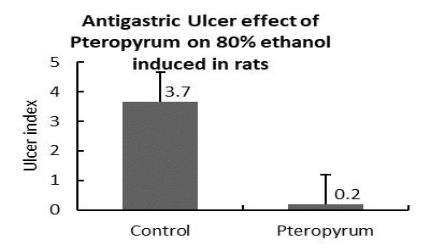
Antigastric Ulcer effect in rats
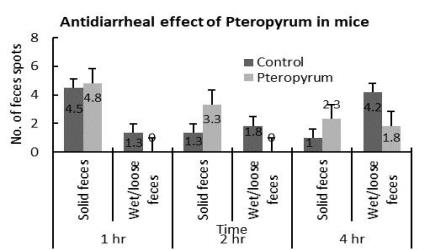
Antidiarrheal effect in mice
Antimicrobial activity
The aqueous extract of the whole plant did not show any anti-microbial activity against Mycobacterium smegmatis, C. tropicalis, different strains of Staphylococcus aureus (Including ATCC 257), strains of Methicillin Resistant Staphylococcus aureus, strains of Streptococcus pyogenes, strains of E. coli (Including ATCC UN 109), different strains of ESBL-producing K. pneumonia, E. coli, Pseudomonas aeruginosa.
References
- Udaya, K.; Acute toxicity, anti-inflammatory and analgesic activities of Pteropyrum aucheri ethanolic extract Fitoterapia (Fitoterapia) 1994, vol. 65, pp. 219-221.
- El-Ghonemy, A. A. (1993). Encyclopedia of Medicinal plants of the United Emirates. 1st Edition. University of U.A.E.
- Fawzi, M. K. (1995). Weeds in the United Arab Emirates. University of U.A.E.
- Jongbloed, M. V., Feulner, G. R., Boer, B. & Western, A. R. (2003). The comprehensive Guide to the Wild Flowers of the United Arab Emirates, Erwda, Abu Dhabi, U.A.E.
- Redo M. C., Rios J. L. , Villar A. A review of some antimicrobial compounds isolated from medicinal plants reported in the literature 1978-1988 Phytotherapy Research, Volume 3, Issue 4 , Pages 117 – 125.
- Mandaville, J. P. (1990). Flora of Eastern Saudi Arabia. Kegan Paul International, Riyadh, Saudi Arabia.
- Miller, A. G. and M. Morris . 1988. Plants of Dhofar, The Southern Region of Oman. Traditional Economic and Medicinal Uses. Diwan of Royal Court Sultanate of Oman—Holmes MC Dougall, Edinburgh, Scotland.
- Western, A. R. (1986). The Flora of United Arab Emirates. An introduction. –Al Ain.
- Western, A. R. (1989). The Flora of United Arab Emirates. An introduction. Publications of the U.A.E. University.
- Sabitha Sakkir*, Maher Kabshawi and Mohamed Mehairbi, Medicinal plants diversity and their conservation status in the UAE, Journal of Medicinal Plants Research Vol. 6(7), pp. 1304-1322, 23 February, 2012.
